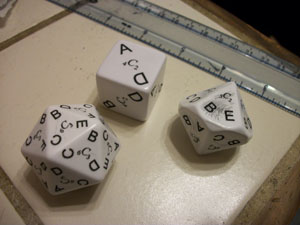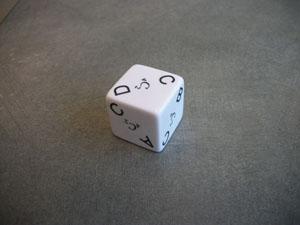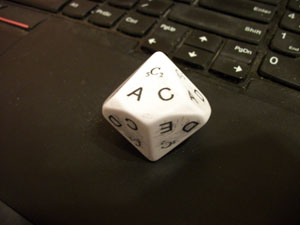Choice Dice
by Eric Harshbarger
Introduction
 Suppose you have a group of six friends, and you need to randomly choose one to go pick up an ordered pizza (or kill a vicious spider lurking in the room, or whatever). With a standard 6-sided die it's a simple matter to make that decision: each person is assigned a different number, 1 to 6, and the die is rolled...
Suppose you have a group of six friends, and you need to randomly choose one to go pick up an ordered pizza (or kill a vicious spider lurking in the room, or whatever). With a standard 6-sided die it's a simple matter to make that decision: each person is assigned a different number, 1 to 6, and the die is rolled...
But what if you want to choose more than just one person? Say three of the six friends need to be put on a team while the remaining three form another team. While this can obviously be done fairly and randomly (with dice, cards, or any other number of methods), the "Choice Dice" I describe on this page can make the process of choosing fair, random, and very quick.
Now, before I go any further, I will admit that this is pretty much a "solution looking for a problem." These will not change your outlook on life, they won't bring you unending bliss (I don't think), and they won't even save you that much time. But, mathematically speaking, and from the perspective of a board game player, they're kind of fun. Also, as I am always designing new types of dice, I was intrigued that I'd never seen such randomizers made or sold before. So, if nothing else, if you are a dice-geek/nerd/collector (and, yes, there are many such people), you might like these for the sheer novelty.
Combinatorics
Now, back to the problem above. If you have 6 people and you want to "choose" 3 of them in which the order of the chosing does not matter, mathematically speaking you are picking a "combination" of 3 people (if the order in which you pick the people does matter, that is a "permutation", and you might want different dice for that). The fact you are choosing people from a group is irrelevant; more generally you may simply think of choosing 3 "items" or "things" from an existing group of 6 items or things.How many different combinations are there in this case? That is, how many different groups of "three from six" things are there?
There's a whole branch of mathematics called "Combinatorics" that deals with counting methods of this sort, and how to determine the number of combinations of "K items from a group of N" is something you'd probably learned on Day 1 of Class 101. The formula is this:
N!/[K!(N-K)!]where the exclamation point (!) indicates the factorial function: N! = N times N-1 times N-2 times N-3 times... and so on down until you multiply by 1. So, for example, 5! = 5x4x3x2x1 = 120 (and before you ask, 0! = 1, by definition).
So, in our posed question, N=6 (the number of items in the original group), and K=3 (the number of items we are choosing). By the formula stated above, there must be 6!/[3!(6-3)!] = 6!/[3!3!] = 720/[6x6] = 720/36 = 20 combinations.
Want more proof? Sure... here are those twenty combinations explicitly listed out if you simply label your original six items A, B, C, D, E, F:
(again, the order of the items does not matter in combinations, so ACF is the same as CFA...)ABC ABD ABE ABF ACD ACE ACF ADE ADF AEF BCD BCE BCF BDE BDF BEF CDE CDF CEF DEF
So there are twenty ways to choose 3 things from a group of 6 things (in mathematical lingo, this would usually be stated as "6 choose 3" and there are many ways it is often denoted; I'll choose this notation: 6C3).
Twenty ways... hmmm... hey!... I can make custom 20-sided dice! Why not...
And thus was the inspiration for my first "Choice Die"; a 6C3 design that looks quite pretty (pictured at right).
It's pretty clear how you use it. You know your task is to pick one of the 6C3 combinations at random (I've put the 6C3 notation in the center of each face so you can remember how many items are in your groups), and you label your items A-F. Roll the die. Three of those items will appear on the face-up side, and those are the three randomly chosen for you with a single roll (in the picture, items A, D, and E are chosen). That's it. Now you can move on with your life.
More Choices
But wait a minute. What if the number of items in your original group is not six? And what if you need to choose some different number besides three of them?Well, that can be handled with separate dice. Let's look at the cases with relatively small numbers of items.
4 Choose 2
 If you are choosing two items from a group of four, there are six different ways to do that (check the math: 6 = 4!/[2!(4-2)!]). 6-sided dice are easy to make, so I've also made one of those (pictured at right). It should now be clear why I'm including the 4C2 notation in the center of the faces -- so, you can easily keep track of which die is used for which N and K values you are needing). The die here simply has all six possible combinations: AB, AC, AD, BC, BD, CD placed its six faces. Roll it, and your two items (chosen from four) are immediately designated for you.
If you are choosing two items from a group of four, there are six different ways to do that (check the math: 6 = 4!/[2!(4-2)!]). 6-sided dice are easy to make, so I've also made one of those (pictured at right). It should now be clear why I'm including the 4C2 notation in the center of the faces -- so, you can easily keep track of which die is used for which N and K values you are needing). The die here simply has all six possible combinations: AB, AC, AD, BC, BD, CD placed its six faces. Roll it, and your two items (chosen from four) are immediately designated for you.
5 Choose 2
 What if you have to choose 2 items from a group of 5 things? That will require a 10-sided die (since 5C2 = 5!/[2!(5-2)!] = 10). This "choice dice project" prompted me to engrave my first 10-sided dice; the results are to the right. (You will note that some of the sides seem to have scratches or marks on them -- this was not done by me; it is from some issue with the manufacture of the blanks that I bought. The scuff marks are unavoidable when inking; let's just say it "adds character" to the dice. The marks certainly do not affect the readbaility of the dice.)
What if you have to choose 2 items from a group of 5 things? That will require a 10-sided die (since 5C2 = 5!/[2!(5-2)!] = 10). This "choice dice project" prompted me to engrave my first 10-sided dice; the results are to the right. (You will note that some of the sides seem to have scratches or marks on them -- this was not done by me; it is from some issue with the manufacture of the blanks that I bought. The scuff marks are unavoidable when inking; let's just say it "adds character" to the dice. The marks certainly do not affect the readbaility of the dice.)
Note, also, that "5 choose 2" has the same number of combinations as "5 choose 3". Why is this? Well, if you are choosing 2 things from 5, then you are not choosing 3 of the things; and you can invert the idea of designation. In other words, how many ways are there to choose 3 things from 5 to put into a separate group, can be re-thought of as simply, "how many ways can I choose 2 of the original 5 things to be left behind -- not put into the group).
So, in other words, you may use this 5C2 die for the case when you have five items and you are trying to choose three items; simply use this die to indicate the two items of the group that are not chosen.
In general, by the formula used above, it should be clear that NCK = NC(N-K).
6 Choose 2
Unfortunately, I don't expect to engrave a die for this case anytime soon. 6C2 = 15. There are no 15-sided dice. Dice with thirty sides are certainly made, and they could be used (simply put each possible result on two faces since 15x2=30), but I do not know of any resource from which I can obtain blank d30s to engrave. Until I do, you are on your own if you need to randomly choose 2 items from a group of 6. I'm sure you'll manage... somehow. Note, this also applies to the "6 choose 4" case as well.Other Cases
Any case where N=7 or greater gets messy because then you start running into dice shapes that don't exist (the factor of 7 really throws a wrench into things). You will also note that I have neglected cases where your K value is simply 1 or N-1 (such as 6C1 or 6C5). This is because you are simply choosing (or not-choosing) 1 item from your group, and thus a standard die can be used (as mentioned in the very first paragraph of this page)... if you want to choose 1 thing out of 6, just roll a standard 6-sided die. And, finally, the case where K=N, such as 6C6, is trivial; you are choosing all of the items from the group, and there is only one way to do that... no die roll is necessary.
Buying Choice Dice
I sell these Choice Dice as a set of three. They are Jumbo-sized (the 6-sided has a 1 inch side length, and the other dice are of appropriate scale). The dice are white with black ink. A set of three costs $20.00 (+shipping). See the purchasing section of my main dice page for more information about ordering dice from me.Back to Eric's Main Dice Page
Copyright © 2015 Eric Harshbarger